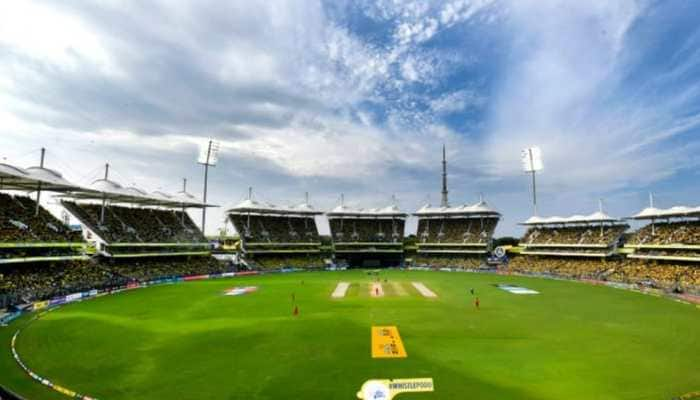As it happened: ISRO`s GSLV-D5 successfully lifts-off from Srihariokota
The Indian Space Research Organisation`s (ISRO) heavy rocket Geosynchronous Satellite Launch Vehicle-Development 5 (GSLV-D5) lifts-off successfully from the spaceport at Sriharikota, Andhra Pradesh at 4.18 pm Sunday.
Trending Photos
)
 Zee Media Bureau
4.42 pm: GSLV-D5 successfully inserts GSAT-14 communication satellite into the orbit
4.25 pm: Cryogenic stage burn out.
4.25 pm: Performance of the cryogenic engine normal at range 150 km.
4.22 pm: Payload faring successfully separates.
4.21 pm: Second stage of GSLV D5 ignited at an altitude of 99 km.
4.20 pm: First stage performance normal
4:18 pm: GSLV-D5 lifts-off from Sriharikota
4:06 pm: Automatic Launch Sequence (ALC) program started
3:59 pm: Mission Director GSLV-D5/GSAT-14 mission authorises Vehicle Director for launch.
The Indian Space Research Organisation`s (ISRO) heavy rocket Geosynchronous Satellite Launch Vehicle-Development 5 (GSLV-D5) lifts-off successfully from the spaceport at Sriharikota, Andhra Pradesh at 4.18 pm Sunday.
The 29-hour countdown for the launch of GSLV-D5 with the indigenous engine began Saturday 11.18 am.
The launch is crucial for India as it seeks to prove the design, realisation and sustained firing of its indigenously built cryogenic engine after two back-to-back failures of the GSLV flights in 2010 — the first, with an indigenous cryogenic engine, on April 15 and the next, with a Russian cryogenic engine, on December 25. The last GSLV launch on August 19, 2013 was called off minutes before the take-off due to leakage of liquid fuel from the rocket’s second stage, wetting the first stage and the four strap-on boosters around it.
The Rs 356 crore launch mission has twin purpose - to flight test the cryogenic engine designed, built by Indian Space Research Organisation (ISRO), and to put in orbit communication satellite GSAT-14.
A cryogenic engine is more efficient as it provides more thrust for every kilogram of propellant burnt. Cryogenic fuels are extremely clean as they give out only water while burning. A successful GSLV-D5 flight will make India the sixth nation to possess this cutting edge technology, joining the United States, Russia, France, Japan and China in an elite club.
According to the ISRO official, the second stage was replaced with a new one built with a different metal.
"We also replaced some critical components in the four strap-on motors of the first stage as a matter of precaution," said the official.
The successful flight of this rocket will be the first step towards building rockets that can carry heavier payloads, up to four tonnes.
For ISRO perfecting the cryogenic engine technology could help the agency save precious foreign exchange by launching communication satellites by itself than depending on foreign rockets.
The GSLV is a three stage/engine rocket. The first stage is fired with solid fuel, the second with liquid fuel and the third is the cryogenic engine.
ISRO is planning to launch an upgraded version of GSLV Mark III rocket soon with a dummy payload.
The design payload capacity of GSLV Mark III is four tonnes. However, the rocket will not have the cryogenic engine which is under development. The mission is mainly to test the rocket`s other systems and its aerodynamic stability.
ISRO has another rocket - Polar Satellite Launch Vehicle (PSLV)- basically to carry lighter weight remote sensing/earth observation satellites.
Officials said that the global trend is communication satellites are growing big and heavier, while the opposite is happening in respect of remote sensing satellites.
ISRO itself is planning to build a six tonne communication satellites. So it is imperative for India to have a rocket of its own than paying huge sums to other space agencies to sling satellites in orbit.
According to ISRO, several design changes had been incorporated in Sunday`s rocket after studying the reasons behind the failure of past GSLV rockets.
Design changes were made in the lower shroud/cover that protects the engine during the atmospheric flight, wire tunnel of the cryogenic stage to withstand larger forces during the flight, and the revised aerodynamic characterisation of the entire rocket.
The space agency also reverted to 3.4 metre heat shield to protect the satellite. The last GSLV rocket that failed had a four-metre heat shield.
One of the earlier GSLV rockets had problems in its aerodynamics.
Other changes included video imaging of lower shroud movement during various flight phases, fuel booster in cryogenic engine, and engine`s ignition sequence, he said.
ISRO said indigenisation of many critical systems, including liquid hydrogen propellant acquisition system (to prevent possibility of outside contamination), was achieved.
ISRO officials said that though the rocket`s rated carrying capacity is around 2.2 tonnes, it was decided to carry a sub-two tonne satellite with minimum number of transponders (receivers and transmitters of communication signals).
ISRO`s earlier attempts to fly a GSLV rocket carrying slightly over two tonne satellites have ended in partial/total failures.
The cuboid shaped Rs. 45 crore GSAT-14 is India`s 23rd geostationary satellites built by ISRO. It has a life span of 12 years.
The 1,982 kg satellite carries six extended C-band and Ku-band transponders (receivers and transmitters of signals), and two Ka-band becons.
During the countdown to the rocket launch, fuelling of the three stage/engine GSLV rocket`s four strap-on motors and the second stage with liquid fuel will be completed, while the first-stage core engine is powered by solid fuel.
It is going to be tense 17 minutes for the ISRO scientists Sunday after the 49.13 metre tall rocket weighing 414.75 tonnes blasts off till the GSLV rocket safely delivers GSAT-14 to augment the Indian transponder capacity. The satellite will be used for telemedicine and tele-education services.
With Agency Inputs
Zee Media Bureau
4.42 pm: GSLV-D5 successfully inserts GSAT-14 communication satellite into the orbit
4.25 pm: Cryogenic stage burn out.
4.25 pm: Performance of the cryogenic engine normal at range 150 km.
4.22 pm: Payload faring successfully separates.
4.21 pm: Second stage of GSLV D5 ignited at an altitude of 99 km.
4.20 pm: First stage performance normal
4:18 pm: GSLV-D5 lifts-off from Sriharikota
4:06 pm: Automatic Launch Sequence (ALC) program started
3:59 pm: Mission Director GSLV-D5/GSAT-14 mission authorises Vehicle Director for launch.
The Indian Space Research Organisation`s (ISRO) heavy rocket Geosynchronous Satellite Launch Vehicle-Development 5 (GSLV-D5) lifts-off successfully from the spaceport at Sriharikota, Andhra Pradesh at 4.18 pm Sunday.
The 29-hour countdown for the launch of GSLV-D5 with the indigenous engine began Saturday 11.18 am.
The launch is crucial for India as it seeks to prove the design, realisation and sustained firing of its indigenously built cryogenic engine after two back-to-back failures of the GSLV flights in 2010 — the first, with an indigenous cryogenic engine, on April 15 and the next, with a Russian cryogenic engine, on December 25. The last GSLV launch on August 19, 2013 was called off minutes before the take-off due to leakage of liquid fuel from the rocket’s second stage, wetting the first stage and the four strap-on boosters around it.
The Rs 356 crore launch mission has twin purpose - to flight test the cryogenic engine designed, built by Indian Space Research Organisation (ISRO), and to put in orbit communication satellite GSAT-14.
A cryogenic engine is more efficient as it provides more thrust for every kilogram of propellant burnt. Cryogenic fuels are extremely clean as they give out only water while burning. A successful GSLV-D5 flight will make India the sixth nation to possess this cutting edge technology, joining the United States, Russia, France, Japan and China in an elite club.
According to the ISRO official, the second stage was replaced with a new one built with a different metal.
"We also replaced some critical components in the four strap-on motors of the first stage as a matter of precaution," said the official.
The successful flight of this rocket will be the first step towards building rockets that can carry heavier payloads, up to four tonnes.
For ISRO perfecting the cryogenic engine technology could help the agency save precious foreign exchange by launching communication satellites by itself than depending on foreign rockets.
The GSLV is a three stage/engine rocket. The first stage is fired with solid fuel, the second with liquid fuel and the third is the cryogenic engine.
ISRO is planning to launch an upgraded version of GSLV Mark III rocket soon with a dummy payload.
The design payload capacity of GSLV Mark III is four tonnes. However, the rocket will not have the cryogenic engine which is under development. The mission is mainly to test the rocket`s other systems and its aerodynamic stability.
ISRO has another rocket - Polar Satellite Launch Vehicle (PSLV)- basically to carry lighter weight remote sensing/earth observation satellites.
Officials said that the global trend is communication satellites are growing big and heavier, while the opposite is happening in respect of remote sensing satellites.
ISRO itself is planning to build a six tonne communication satellites. So it is imperative for India to have a rocket of its own than paying huge sums to other space agencies to sling satellites in orbit.
According to ISRO, several design changes had been incorporated in Sunday`s rocket after studying the reasons behind the failure of past GSLV rockets.
Design changes were made in the lower shroud/cover that protects the engine during the atmospheric flight, wire tunnel of the cryogenic stage to withstand larger forces during the flight, and the revised aerodynamic characterisation of the entire rocket.
The space agency also reverted to 3.4 metre heat shield to protect the satellite. The last GSLV rocket that failed had a four-metre heat shield.
One of the earlier GSLV rockets had problems in its aerodynamics.
Other changes included video imaging of lower shroud movement during various flight phases, fuel booster in cryogenic engine, and engine`s ignition sequence, he said.
ISRO said indigenisation of many critical systems, including liquid hydrogen propellant acquisition system (to prevent possibility of outside contamination), was achieved.
ISRO officials said that though the rocket`s rated carrying capacity is around 2.2 tonnes, it was decided to carry a sub-two tonne satellite with minimum number of transponders (receivers and transmitters of communication signals).
ISRO`s earlier attempts to fly a GSLV rocket carrying slightly over two tonne satellites have ended in partial/total failures.
The cuboid shaped Rs. 45 crore GSAT-14 is India`s 23rd geostationary satellites built by ISRO. It has a life span of 12 years.
The 1,982 kg satellite carries six extended C-band and Ku-band transponders (receivers and transmitters of signals), and two Ka-band becons.
During the countdown to the rocket launch, fuelling of the three stage/engine GSLV rocket`s four strap-on motors and the second stage with liquid fuel will be completed, while the first-stage core engine is powered by solid fuel.
It is going to be tense 17 minutes for the ISRO scientists Sunday after the 49.13 metre tall rocket weighing 414.75 tonnes blasts off till the GSLV rocket safely delivers GSAT-14 to augment the Indian transponder capacity. The satellite will be used for telemedicine and tele-education services.
With Agency InputsStay informed on all the latest news, real-time breaking news updates, and follow all the important headlines in india news and world News on Zee News.
Advertisement
Live Tv
Advertisement







)
)
)
)
)
)
)
)
)
)
